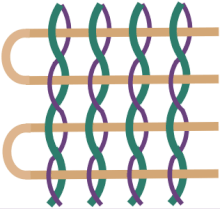Leno_weave
Leno weave
Weave in which two warp yarns are twisted around the weft yarns
Leno weave (also called gauze weave or cross weave)[1] is a weave in which two warp yarns are woven around the weft yarns to provide a strong yet sheer fabric. The standard warp yarn is paired with a skeleton or 'doup' yarn; these twisted warp yarns grip tightly to the weft which causes the durability of the fabric. Leno weave produces an open fabric with almost no yarn slippage or misplacement of threads.
This article needs additional citations for verification. (October 2021) |
